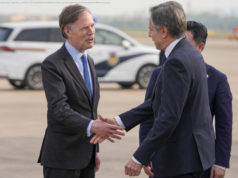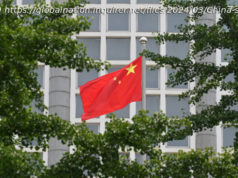Beijing is warning of a possible trade war — but also hinting it’s open to a compromise.
President Donald Trump is preparing to unveil his biggest crackdown on China yet: $60 billion worth of tariffs on Chinese exports to the US. The measure is intended to punish Beijing for stealing intellectual property from American companies.
The bold move — which is expected by Friday — has prompted China to promise to reform its trade and investment practices and hint that it could come to some kind of compromise with the US.
Analysts and the US business community contend that China forces many foreign businesses to hand over their most prized technology in exchange for access to China’s coveted market. It’s an unfair practice because China’s state-owned companies then have the ability to use that tech to develop their own products — and beat the foreign businesses at their own game.
The $60 billion in annual tariffs that the US plans to impose would be applied to more than 100 Chinese products like electronics that the Trump administration says were developed using stolen trade secrets. The total number of tariffs could change before the policy is formally unveiled.
The administration also says the tariffs should create American jobs by blocking foreign competition.
In early March, US Trade Representative Robert Lighthizer, a China hawk and proponent of tariffs, reportedly presented the president with a plan to hit China with $30 billion worth of tariffs. But Trump rejected the package and asked for something bigger. It’s now looking like the White House is going for double what his top trade official recommended.
US companies that rely on Chinese imports are unhappy about the move. A number of US industries have lobbied against the proposed tariffs, arguing that they’ll raise costs for their businesses and push up the price of the many cheap Chinese goods US consumers rely on, ranging from electronics to toys to footwear. A group of 25 retail giants including Walmart and Costco sent a letter to the White House on Monday petitioning against the tariffs.
Beijing, for its part, suggested it would take action in response. At a news conference on Tuesday, Chinese Premier Li Keqiang conceded that “there is still broad room for us to further open up,” referring to the strict regulations around entering China’s market. He also acknowledged that the $375 billion US-Chinese trade deficit is not “sustainable.”
Todd Tucker, a trade scholar at the Roosevelt Institute, told me that China could, for example, try to avoid tariffs by offering up some kind of concrete concession to the US like dropping its ongoing bid for market economy status at the World Trade Organization. That move, which would allow Washington to keep current taxes on lots of Chinese goods under anti-dumping laws, would mean that Trump could claim a win and also allow Beijing to avoid widespread tariffs.
But Beijing’s talk of reform doesn’t mean that it is expecting to turn the other cheek if Trump follows through on his threat. It’s unclear what their response will be, but Li asked Washington to “act rationally” and warned that “no one will emerge a winner from a trade war.”
The White House plans to impose the new tariffs using Section 301 of the Trade Act of 1974. It’s a statute that the US has historically used to force countries to open up their markets when the country in question restricts access to American exporters.
This law also allows the US to unilaterally impose tariffs on a foreign country’s exports or restrict its access to the US market.
Washington has had great success with using Section 301 in the past, like when it pried open Japan’s impenetrable semiconductor market in the 1980s. But the statute is widely considered to be outdated since the creation of the WTO in 1995.
Trade experts like Chad Bown, a senior fellow at the pro-free trade Peterson Institute for International Economics, have argued that using Section 301 will deal a blow to the credibility and stability of the global trading system.
Back in the ’80s, might made right when it came to trade disputes, and unilateral action was commonplace. Today, the WTO acts as the world’s Supreme Court for trade and countries usually take their grievances with other countries to its dispute settlement system rather than taking action on their own. The idea is by sorting out differences through an orderly, rules-based system, countries are able to avoid costly trade wars.
Analysts say that if the US feels free to buck the WTO’s system they could inspire other countries to do so as well — and set off a wave of trade wars.
But a more immediate concern for the US is China’s reaction. “The Chinese will retaliate,” William Reinsch, a trade expert at the Stimson Center, a nonpartisan think tank, told me in an interview in January. “They have a lot of experience with this game — and they are very, very good at coming up with things that will cost them nothing and cost us a lot.”
China could retaliate with tariffs of its own or try to punish American businesses in other ways by doing things like interfering with the US’s supply chains in China.
The US company Boeing, which says that one out of every four of its jetliners is bought by the Chinese, could be a prime target for Bejing. China could decide to stop ordering aircraft from Boeing or cancel existing orders.
Reinsch said Beijing could also decide to halt huge US agricultural exports to China like soybeans or slow or shut down the assembly of Apple iPhones, which are manufactured in China.
One thing’s clear: Trump is navigating a tricky scenario. On one hand, threatening to use punishing tariffs might be the only way to get China’s attention and persuade it to come to the negotiating table. On the other hand, if Trump actually pulls the trigger, Beijing could still hit back pretty hard.






